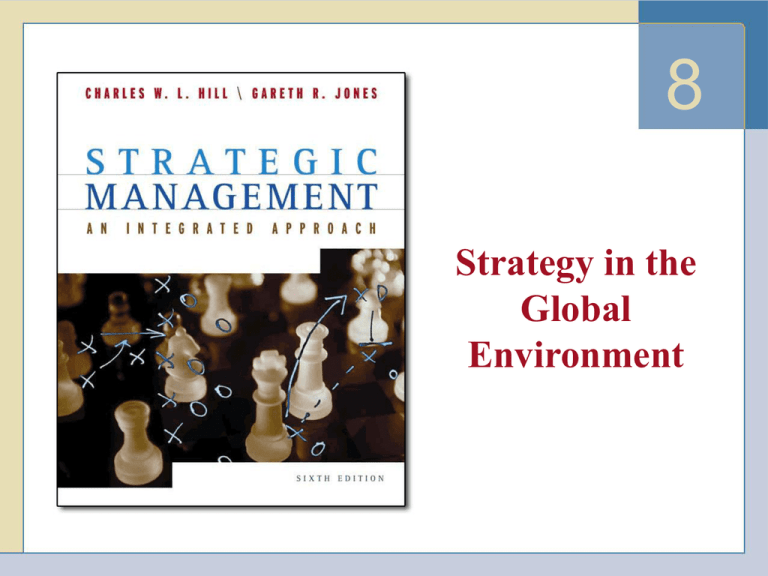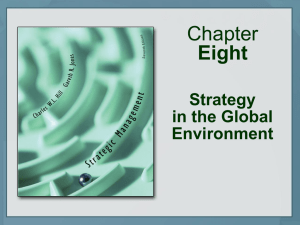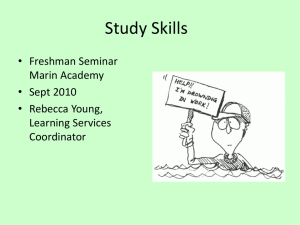
8
Strategy in the
Global
Environment
Increasing Profitability Through Global
Expansion
• Location economies
– Economic benefits from performing a value
creation activity in the optimal location
– Effects
• Can lower costs
• Can enable differentiation
– Caveats
• Transportation costs and trade barriers
• Political and economic risks
Copyright © Houghton Mifflin Company. All rights reserved.
8-2
Increasing Profitability Through Global
Expansion (cont’d)
• The experience curve
– Serving a global market from one or a few plants is
consistent with moving down the experience curve
and establishing a low-cost position
• Transferring distinctive competencies
– Companies with distinctive competencies can
realize large returns by expanding to global
markets where competitors lack similar
competencies and products
Copyright © Houghton Mifflin Company. All rights reserved.
8-3
Increasing Profitability Through Global
Expansion (cont’d)
• Leveraging the skills of global subsidiaries
– Competencies can be created anywhere within a
multinational’s global network of operations
– Managers must establish an incentive system to
encourage local employees to acquire new
competencies
– Managers must have processes in place to identify
valuable new competencies and help transfer them
within the company
Copyright © Houghton Mifflin Company. All rights reserved.
8-4
Pressures for Cost Reductions and Local
Responsiveness
Copyright © Houghton Mifflin Company. All rights reserved.
8-5
Pressures for Cost Reductions
• When companies produce commodity products
• Where differentiation on nonprice factors is difficult
and price is the main competitive weapon
• Where competitors are based in low-cost locations
• Where there is persistent excess capacity
• Where consumers are powerful and face low
switching costs
• The liberalization of the world trade and investment
environment
Copyright © Houghton Mifflin Company. All rights reserved.
8-6
Pressures for Local Responsiveness
• Differences in customer tastes and preferences
• Differences in infrastructure and traditional
practices
• Differences in distribution channels
• Host government demands
Copyright © Houghton Mifflin Company. All rights reserved.
8-7
Four Basic Strategies
Copyright © Houghton Mifflin Company. All rights reserved.
8-8
Choosing a Global Strategy
• International strategy
– Creating value by transferring competencies and
products to foreign markets where indigenous
competitors lack those competencies and products
– Makes sense if a company has a valuable
competence that indigenous competitors in foreign
markets lack and if it faces weak pressure for local
responsiveness and cost reductions
Copyright © Houghton Mifflin Company. All rights reserved.
8-9
Choosing a Global Strategy (cont’d)
• Multidomestic strategy
– Developing a business model that allows a
company to achieve maximum local
responsiveness
– Makes sense when there are high pressures for
local responsiveness and low pressures for cost
reductions
– Companies may become too decentralized and lose
the ability to transfer skills and products
Copyright © Houghton Mifflin Company. All rights reserved.
8 - 10
Choosing a Global Strategy (cont’d)
• Global strategy
– Focusing on increasing profitability by reaping
cost reductions that come from experience curve
effects and location economies; pursuing a lowcost strategy on a global scale
– Makes sense when there are strong pressures for
cost reductions and demand for local
responsiveness is minimal
Copyright © Houghton Mifflin Company. All rights reserved.
8 - 11
Choosing a Global Strategy (cont’d)
• Transnational strategy
– Simultaneously seeking to lower costs, be
locally responsive, and transfer
competencies in a way consistent with
global learning
Copyright © Houghton Mifflin Company. All rights reserved.
8 - 12
Cost Pressures and Pressures for Local
Responsiveness Facing Caterpillar
Copyright © Houghton Mifflin Company. All rights reserved.
8 - 13
Advantages and Disadvantages of Different
Strategies for Competing Globally
Copyright © Houghton Mifflin Company. All rights reserved.
8 - 14
Basic Entry Decisions
• Which overseas markets to enter
– Assessment of long-run profit potential
• A function of the size of the market, purchasing power
of consumers, the likely future purchasing power of
consumers
– Balancing the benefits, costs, and risks associate
with doing business in a country
• A function of economic development and political
stability
Copyright © Houghton Mifflin Company. All rights reserved.
8 - 15
Basic Entry Decisions (cont’d)
• Timing of entry
– First-mover advantages
– First-mover disadvantages
• Scale of entry and strategic commitments
– Entering on a large scale is a strategic
commitment, both positive and negative
– Benefits and drawbacks of small-scale entry
Copyright © Houghton Mifflin Company. All rights reserved.
8 - 16
The Choice of Entry Mode
•
•
•
•
•
•
Exporting
Licensing
Franchising
Joint ventures
Wholly-owned subsidiaries
Choosing Among Entry Modes
Copyright © Houghton Mifflin Company. All rights reserved.
8 - 17
The Advantages and Disadvantages of
Different Entry Modes
Copyright © Houghton Mifflin Company. All rights reserved.
8 - 18
Choosing Among Entry Modes
• Distinctive competencies and entry mode
– Technological competency
• Wholly-owned subsidiary is preferred over licensing
and joint ventures
– Management competency
• Franchising, joint ventures, subsidiaries
• Pressures for cost reduction in entry mode
– Great pressure for cost reductions
• Exporting and wholly-owned subsidiaries
Copyright © Houghton Mifflin Company. All rights reserved.
8 - 19
Global Strategic Alliances
• Advantages
–
–
–
–
Facilitate entry into a foreign market
Share fixed costs and associated risks
Bring together complementary skills and assets
Set technological standards to the industry
• Disadvantages
– Give competitors a low-cost route to gain new
technology and market access
Copyright © Houghton Mifflin Company. All rights reserved.
8 - 20
Making Strategic Alliances Work:
Partner Selection
• A good partner:
– Helps the company achieve strategic goals
– Shares the firm’s vision for the purpose of the
alliance
– Is unlikely to try to exploit the alliance to its own
ends
• Conduct research on potential partners
Copyright © Houghton Mifflin Company. All rights reserved.
8 - 21
Structuring Alliances to Reduce
Opportunism
Copyright © Houghton Mifflin Company. All rights reserved.
8 - 22
Making Strategic Alliances Work:
Managing the Alliance
• Sensitivity to cultural differences and their
effects on management style
• Building interpersonal relationships among
managers from different companies
• Ability to learn from alliance partners and put
the knowledge to good use
Copyright © Houghton Mifflin Company. All rights reserved.
8 - 23








